Determination of Noise Pollution Level in Dire-Dawa City, Ethiopia - Juniper Publishers
Juniper Publishers- Open Access Journal of Environmental Sciences & Natural Resources
Determination of Noise Pollution Level in Dire-Dawa City, Ethiopia
Authored by Kinfe Mesfin
Abstract
Environmental pollution is a worldwide problem. Noise pollution together with air and water pollution make life on earth uncomfortable. Noise pollution is a threat for humans and animals of all strata throughout our planet earth. It creates a number of physical and mental ailments in humans. Exposure to high levels of noise pollution leads to nervous disorders, heart attack, high blood pressure and short memories. Fatigue of the hearing organs, deafness and physical losses are among the many public health risks of noise pollution. The ill-effects of noise pollution on animals include hearing loss and increase in heart rate. High intensity sound induces fear in animals, forcing them to abandon their habitat. Anxious behavior in animals, decrease in animal's milk production, and decrease in birds' ability to hunt prey, and disruption in the breeding and feeding patterns of some animals is one of the major impacts of noise pollution on animals. Noise pollution also contributes to the extinction of certain species on earth.
The objective of this study was to determine the noise pollution level in the city and disseminate the result to the city administration so that they can take correction measures that could alleviate the existing problem. The methodology employed was purposive area and sampling site selection on field visit and noise level measurement using a digital noise level Testo 816 sound meter. The results of the study also indicated that the average noise level measured at commercial, residential and mixed sites was higher than the acceptable limit set by the world health organization and the standard which Ethiopia is using currently. But the results obtained for industrial sites was below the Ethiopian and WHO set standards and this is accounted for the low number of industries functioning in the selected areas.
Keywords: Standard; Permissible; Pollution; Risk; Extinction; Measured values
Introduction
One of the serious and most often overlooked issues about environmental pollution is noise pollution. Noise is seen as a normal phenomenon. Action plans and subsequent acoustical planning are not seriously considered in many parts of the world. As a result, the impact of noise is not well understood [1]. Noise, another form of environmental pollution creates a number of physical and mental ailments in humans. Exposure to high levels of noise pollution is a cause for nervous disorder, headache, high blood pressure and short memories. Noise also interferes with performance of the hearing mechanism, biological functioning of the body and sociological behaviors. Annoyance, irritation, nuisance and privacy invasion are potential impacts of long term exposure to high levels of noise pollution. Fatigue of the hearing organs, deafness and physical losses are also included among the many serious public health risks of noise pollution [2,3].
Noise is unwanted sound. It occurs in the environment as a result of many activities. Aircraft traffic, vehicles, construction, churches, street dogs and neighbors can be sources of noise. Exposure to excessive noise levels also cause negative psychological and psychosocial impacts on humans and animals. Long term exposure to intense levels of noise lead to personality changes and violent reactions. An addiction to loud music is also a psychological impact of noise pollution exposure to loud music. Noise pollution which is an underestimated source of environmental stress is also a cause for serious health problems, including hearing impairment, heart disease, Communication barrier, poor cognitive function and sleep disturbances. Excess noise is long known to be a serious risk factor for human health. An estimated 100 million people are exposed to unhealthy levels of noise pollution from automobile and aircraft traffic in the US [4-7]. Exposure to traffic noise elevate stress hormones leading to high blood pressure, stroke and heart failure resulting in the deaths of about 210,000 people in Europe each year.
Beyond these effects, elevated noise levels can create stress, increase workplace accident rates, and stimulate aggression and other anti-social behaviors, the most significant causes being vehicle and aircraft noise, prolonged exposure to loud music and industrial sound [8,9]. Hearing loss as a result of occupational exposure is one of the most common work-related illnesses. In the United States, more than 22 million workers are exposed to hazardous noise pollution every year and are at a higher risk of developing hearing loss. A constant loud sound can make people tense and anxious, and disturb emotional balance [10]. Noise pollution can make the Earth an uncomfortable place for animals too. Hearing loss and increase in heart rate are some of the ill-effects of noise pollution on animals. High intensity sound induces fear in animals, forcing them to abandon their habitat. Anxious behavior in animals, decrease in milk production and birds' ability to hunt prey, and disruption in the breeding and feeding patterns of some animals is one of the major impacts of noise pollution on animals. This condition sometimes result in the extinction of certain species on earth [11,12].
Material and Method
Site description
This research study was conducted in Dire Dawa, one of the two chartered cities in Ethiopia. It is the second largest city in Ethiopia. It hosts several industries, businesses, markets and an international Airport and a railway Station, created in 1897 and links the area with Addis Ababa and the French port at Djibouti. The city has a population of 341,834 of which 68.23 % are urban inhabitants. The biggest market centers named Taiwan and Qefira are found in the city. The two markets attract many people from all parts of the country including tourists. Thus, the city is always overcrowded by people and vehicles causing high noise pollution in the area. Transportation in the city is served by Taxi, buses, Airplane and horse pulled carts. The city has a warm and dry climate with a relatively low precipitation. The mean annual temperature is 25.9°C, while the average maximum temperature is 32.8°C. The average annual rainfall is about 583 mm. Urbanization is rapidly growing in the city with consequences of alarming man- made noise pollution that could endanger the health security of the public (Figure 1).
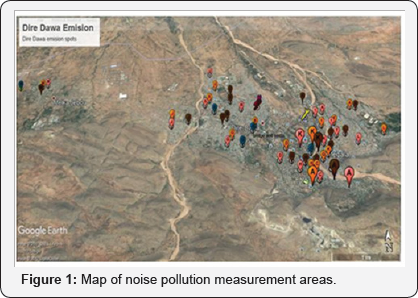
Method
Commercial, Industrial, Mixed and Residential sites from 18 areas initially identified by field observation were purposely selected. The noise levels in each of the four sites were measured using calibrated sound level meter. The data was collected twice a day at peak hours, between 8:00-11:00 AM and 4:00-7:00 PM in the morning and afternoon respectively. The time selection was based on the intensity of vehicle and human mobility and various activities carried out in the areas. As sound varies in level with time, it is commonly described statistically in terms of exceedence levels which helped to summarize the percentage of time a noise level was exceeded during the measurement period at the sampling points. Analysis of the data was done by classifying the study sites into groups (18) based on population density, dense transportation and large economic activities. Then from each classified areas, four sampling sites (commercial, industrial, residential and, mixed) were chosen. A digital noise level Testo 816 sound meter, with sound level measurement range 30-80dB, 50-100dB and 80-130dB, an automatic range switchover, two time weightings, two frequency weightings, a maximum/minimum function, display light and a tripod screw were used during the noise level measurement. The "Slow" time weighting was used to capture noises whose signals only change slowly. The Noise levels were logarithmically averaged(L) as L1, L2, Ln = Average noise level (L) = 10 x log10 ([10L1/10 + 10 L2/10 + ---. +10 Ln/10] / N) Where, L= Average noise level (dBA), L1, L2 ...ln = Observed noise levels from 1 to nth, (in dBA). N= Total number of observed noise levels. During all processes of calculation, the order of the recorded noise values was maintained properly. The measurement was taken on calm and non-disturbing conditions i.e. in the absence of rain, wind disturbance and other interfering noise generating activities nearby. The data collection and data analysis was conducted in the months of July and August, 2017 G.C.
Results
As we can see on (Figure 2), all the measured values of commercial, residential, mixed and industrial areas are above the permitted standard values set by the Ethiopian environmental protection Authority (EPA) and the world health organization (WHO).The mixed areas average noise level is at the highest pick (77.409 ± 5.63dB (A)) but Ethiopia has no a set standard for mixed areas. During the study period measurement was taken from eighteen selected commercial areas in the city Administration. The minimum average noise level was 62.38 ± 4.515 dBA at Addis Ketema and the maximum Average nose level was 81.98 ± 4.515 dBA at Qefira. In all cases the measured values of noise are above the standard values put in place in the Ethiopian standard (65 dB (A)). Similarly, the maximum average noise values in a commercial area as set by WHO standard is 70 dB (A). Therefore, commercial areas mostly indicate average noise level values greater than those permitted by the Ethiopian and world health organization (WHO) standards (Figure 3).This increment in sound level is attributed to the various activities and human interactions associated with the nature of commercial areas. Sound pollution level was measured in all residential sites from the 18 areas selected previously (Figure 4). The maximum average noise level was found to be 68.08 ± 14.78 dB A at Addis ketema and the minimum (52.258 ± 14.78dBA) at Afetesa. But the average permitted noise pollution level of residential areas of the country is 55 dB (A) and that of world health organization 45 dB (A). Thus, the measured noise level values at most of the residential sites is higher than those values permitted by Ethiopia and the world health organization which in turn indicates exposure of the city community to the dangers associated with high levels of ambient noise pollution (Figure 5).
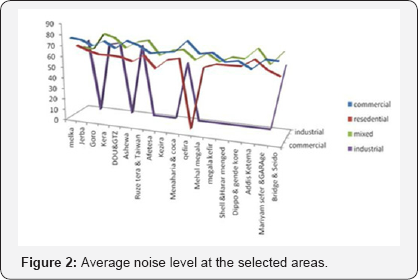
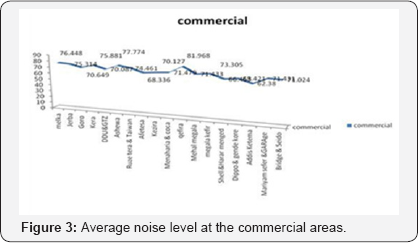
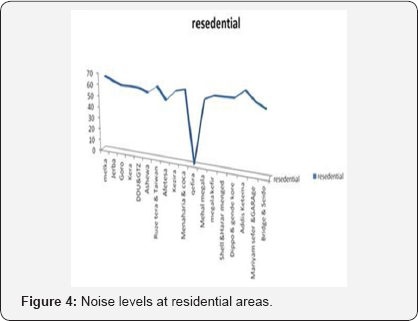
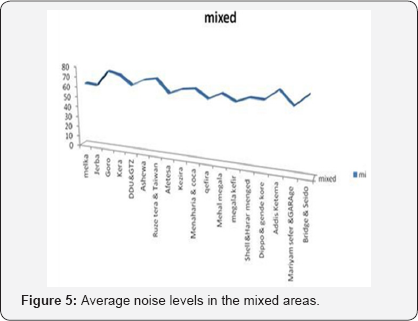
The highest average noise level was measured at Goro (77.409 ± 5.63dB (A)) and Mariam safer (60.329 ± 5.63 dB (A)) mixed sampling sites. This value is far above the permitted average noise levels for industrial (75 dB (A) and commercial (65 dB (A)) areas of the country. Mixed areas naturally comprise many people with a variety of activities existing close together and this condition is likely responsible for the increase in the levels of noise pollution at Goro and Mariam Sefer sites. However, the lack of acceptable standard for noise pollution level for mixed areas in the country is a challenge to decide whether or not noise pollution is a health risk in mixed areas across the country. As can be seen in (Figure 6), there were six areas having industries functioning under capacity. The remaining industries were not functional and noise level measurement was limited to only six industrial areas. The average maximum noise level was recorded at melka (67.408 ± 4.42 dB (A)) and the minimum at Menaharia Coca (54.052 ± 4.42 dB (A)) site. The measured noise pollution values indicated that the status of noise pollution level at the industrial areas was below the permitted standard (75 dB (A)) limit in the country.
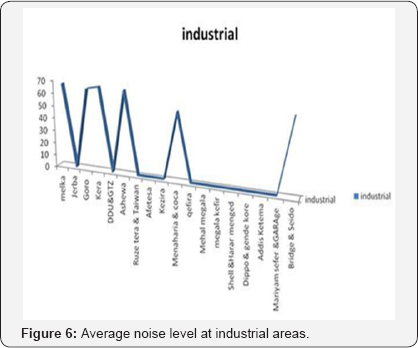
Discussion and Recommendations
Ambient noise level measurement was conducted at commercial, Industrial, Mixed and Residential sites purposely selected from 18 areas in the city Administration of Dire-Dawa, one of the largest cities in Ethiopia. The measured average noise level value for commercial site is in the ranges of 62.38 dB to 81.81.96 dB, the highest record at Qefira which is the hot spot for business activities. The highest average noise level value for residential area is 68.08 dB at Addis ketema and that of mixed area 77dB and 60.32dB at Goro and Mariam Sefer areas. These values are far above the permitted noise level values set by Ethiopia for commercial (65dB) and Residential (55dB) and world health organization (70dB and 45dB) respectively. The highest average noise level value for Industrial sites is obtained to be 67.4dB at Melka area and the lowest at Menaharia Coca (54.05dB) which is the lowest values as compared to the recorded values at commercial, residential and mixed sites and this deviation is mainly attributed to the less number of industries functioning in the industrial areas (Tables 1 & 2).

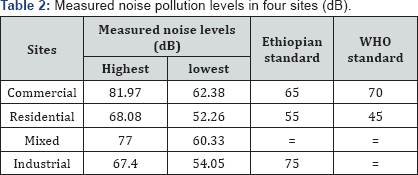
In general the measured noise level values obtained for commercial, residential and mixed sites are all above the permissible limit values set by Ethiopia and world health organization indicating an excessive noise level prevailing in the city administration. The highest noise level at Qefira for commercial (81.96dB) is that Qefira is a hot market center where many people gather together to buy and sell goods and the highest noise level value at Addis ketema (68.08 dB) for residential is due to the fact that the area is not only restricted for residential but also for commercial and industrial activities. The average noise level record for mixed sites exceeded the permissible limits set by Ethiopia and world health organization for commercial, Industrial and residential sites and this is due to the fact that mixed areas serve both as a site for commercial and industrial activities as well as for residential purposes. Therefore, it can be concluded that Dire Dawa City is currently found under a threat of high level noise pollution. Environmental noise pollution is a health hazard in all populous and fast growing cities. The problem of noise pollution unlike water and air pollution did not receive proper attention in most areas. The public due to lack of awareness and training on the risks involved with noise pollution do not take any safety precaution and is vulnerable to the unavoidable harmful impacts. Hence, proper land use planning, implementable laws, acceptable standard and community awareness through training need to be carried out to protect the public as well as to maintain the noise pollution level with in the permissible standards.
For more articles in Juniper Publishers | Open Access Journal of Environmental Sciences & Natural Resources please click on: https://juniperpublishers.com/ijesnr/index.php



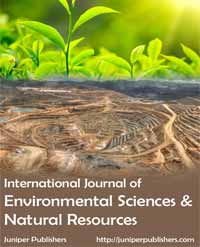
Comments
Post a Comment